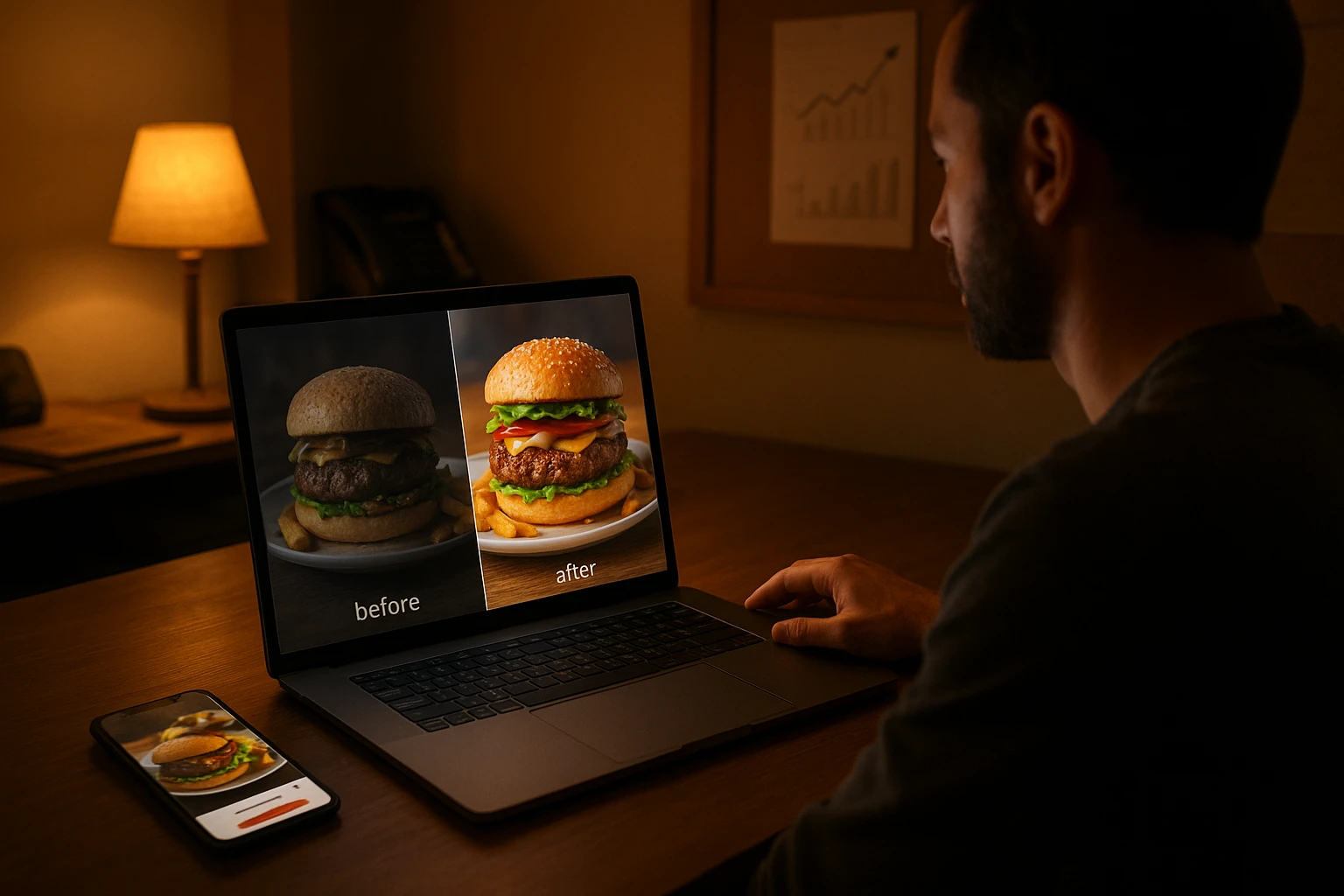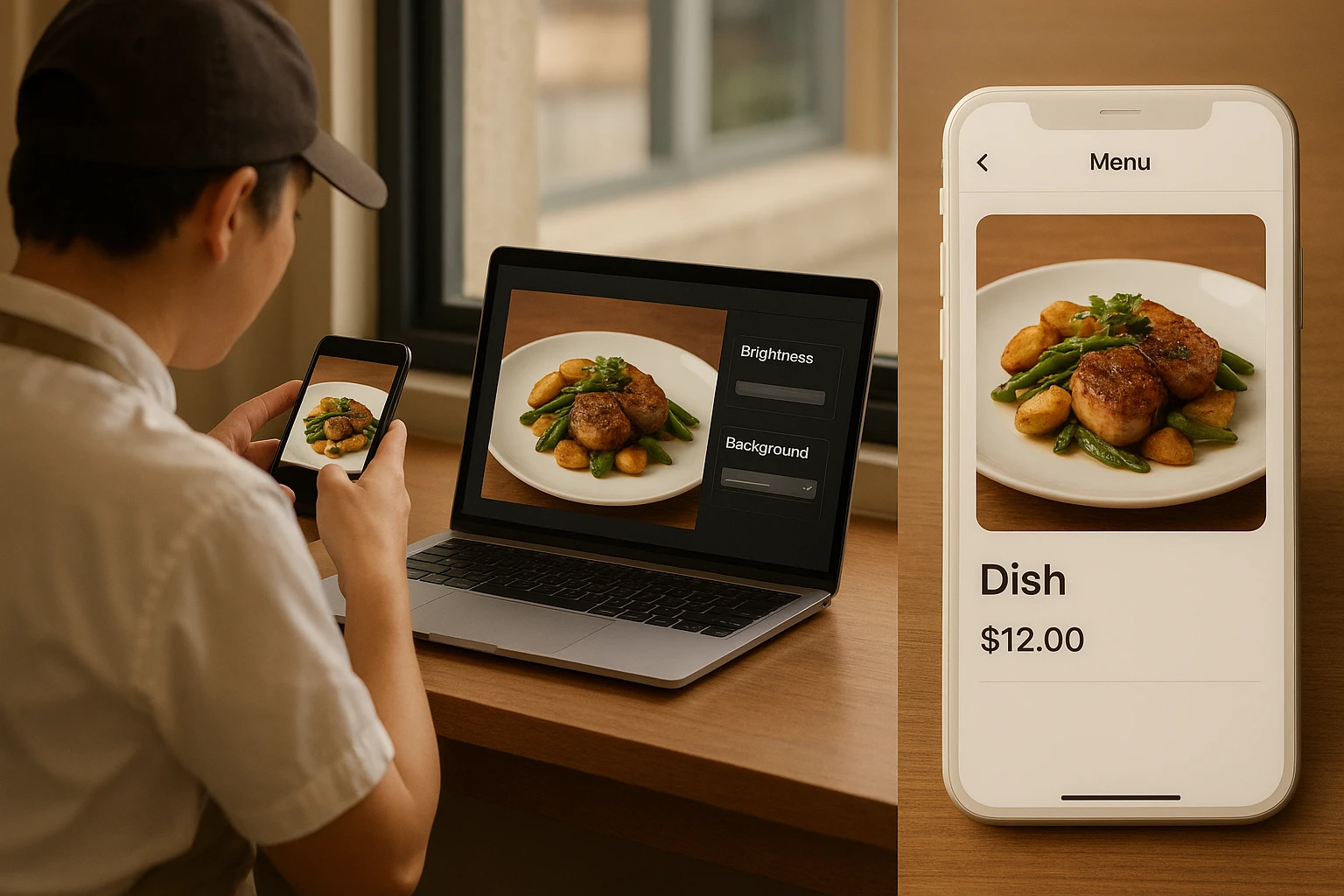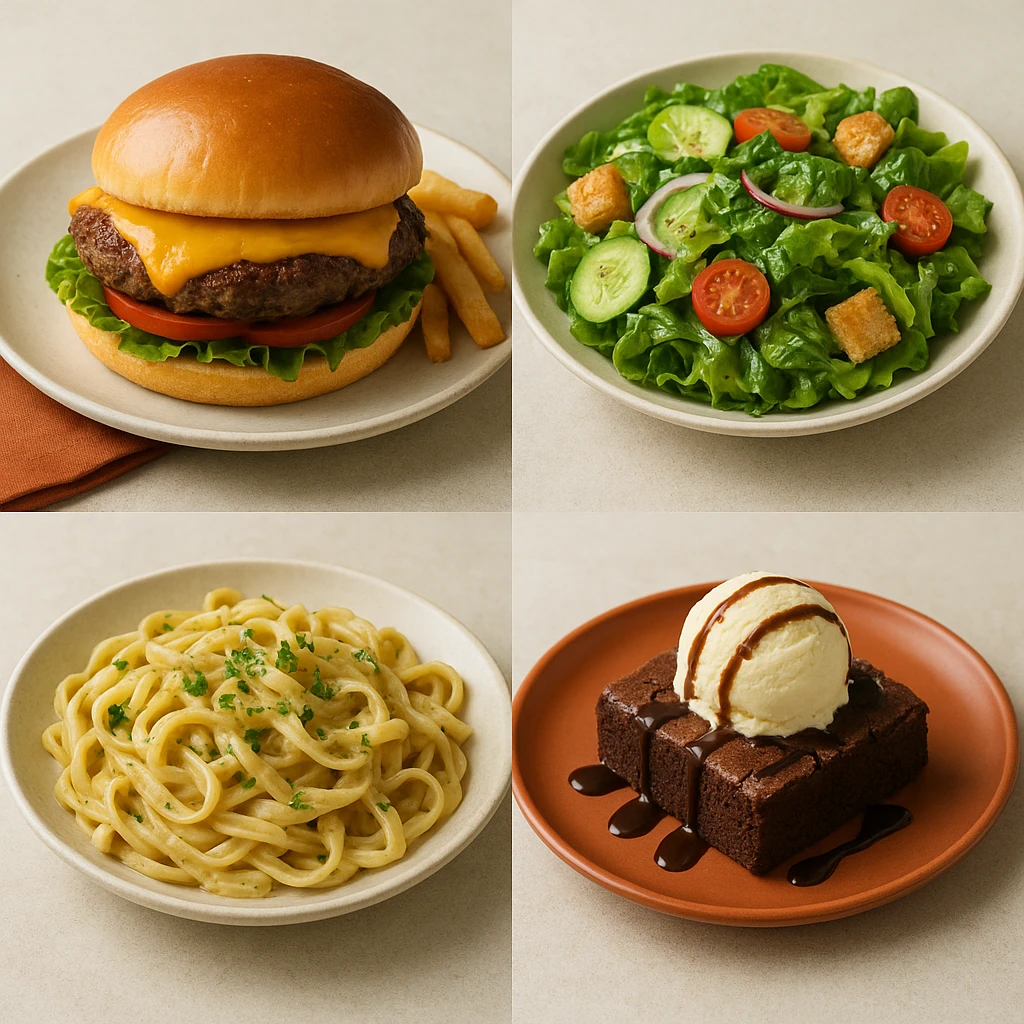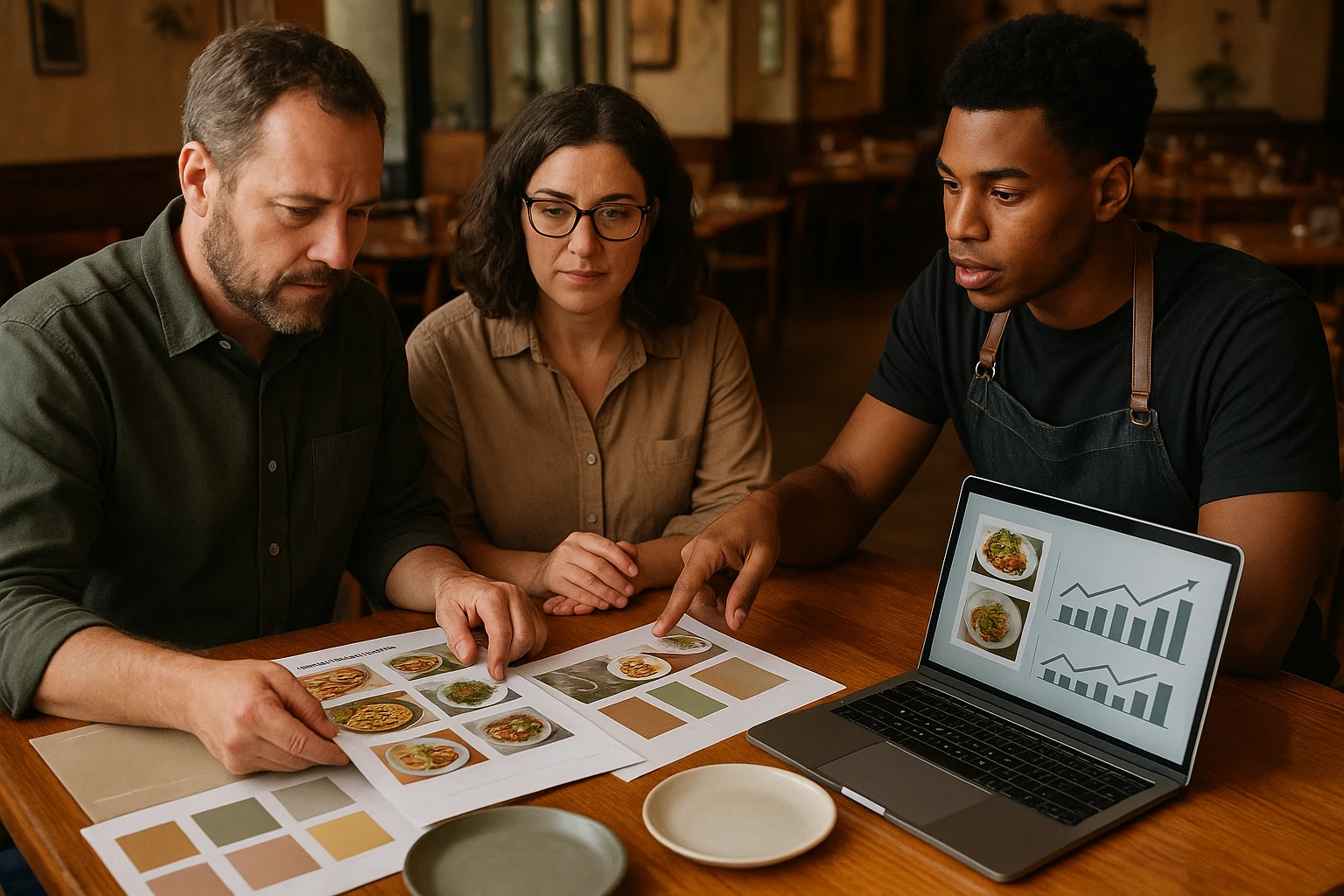How AI is Revolutionizing Food Photography for Small Restaurants

Quick navigation:
- 1. Why AI Food Photography Is Finally Built for Small Restaurants
- 2. From Smartphone Snap to Menu-Ready: A Simple AI Workflow
- 3. Brand Safety, Honesty, and Consistency in AI Food Imagery
- 4. Turning AI Photos into Revenue: Menus, Apps, and Campaigns
- 5. Build a Repeatable AI Visual System, Not One-Off Magic
1. Why AI Food Photography Is Finally Built for Small Restaurants
A familiar scene: it’s close to midnight, you’re scrolling through a delivery app, and your burgers or biryanis look small, dark, and cramped next to the big chains’ glossy photos. The food in-house is great. The photos make it look like an afterthought.
For years, the fix was a $2,000+ photoshoot with a photographer, stylist, and a day of prep. That’s not realistic when you’re wrestling labor, rent, and food costs. Yummify exists because AI finally makes professional-looking restaurant menu photos achievable with what you already have: a smartphone, a window, and a bit of process.
Why better photos now matter more than ever
On delivery apps, the photo is often the only chance you get. DoorDash explicitly recommends bright, zoomed-in shots and notes that high-quality images are more likely to be featured and clicked in their guides for merchants (According to DoorDash’s restaurant food photography guide). If your bestsellers look dull or tiny in the thumbnail, guests swipe past and the algorithm learns you’re not a top pick.
Off-app, Google and Maps are doing the same thing. Strong food photos help people choose where to book and what to order. When your images are inconsistent or outdated, your reviews are doing the heavy lifting with no visual support.
What AI changes for small operators
Generative AI isn’t just a novelty filter anymore. It can now:
- Fix bad lighting and white balance from a quick phone snap.
- Extend and clean up backgrounds so any table can look like a mini studio.
- Apply a consistent style-“bright fast casual” or “cozy trattoria”-across every dish.
Restaurant Business Online reports that operators are already using AI to speed up marketing tasks and keep visuals fresh between major campaigns. Yummify turns that raw AI power into restaurant-specific workflows: branded style presets, simple upload flows, and exports tailored for delivery apps and QR menus.
Instead of a once-a-year shoot, you can realistically refresh 5-10 high-impact dishes in the next 30 days, then keep rolling as menu items change.
Quick checklist: Are you leaving money on the table?
- Your top sellers have photos older than 12 months.
- Thumbnails on delivery apps look dark, zoomed out, or inconsistent.
- Google Images for your restaurant show old dishes or guest photos you’d never print.
- You avoid seasonal menu changes because you “don’t have the photos.”
Invite the reader to quickly compare their current delivery-app photos to nearby competitors and note where their images feel small, dark, or inconsistent.
Summary: Section 1 contrasts expensive legacy photoshoots with today’s AI workflows, explains why strong food visuals now directly impact discovery and orders, and positions Yummify as a practical way for small restaurants to refresh 5-10 key dishes in 30 days.

2. From Smartphone Snap to Menu-Ready: A Simple AI Workflow
You don’t need a DSLR, Lightroom, or a spare day off the line to get strong AI food images. You need a simple capture habit and a repeatable workflow your team can run between tickets.
Here’s a practical seven-step flow that turns a quick smartphone shot into platform-ready restaurant marketing visuals with Yummify.
Smartphone-to-AI Workflow: 7 Simple Steps
- Pick 3-5 priority dishes. Think: top sellers, signature items, or anything you’re pushing in promos.
- Capture 3-4 angles near a window. Seat a plate by a bright window or open door, turn off flash, and shoot:
- Overhead (flat lay)
- 45? angle (how guests see it)
- Close-up on key texture (melted cheese, sear, garnish)
- Keep the scene clean. One neutral plate, one napkin, no messy tickets or POS in the frame.
- Upload to Yummify and pick your preset. Choose a cuisine-specific style (e.g., “modern ramen bar,” “rustic taqueria”) so every dish lands in the same visual world.
- Apply AI enhancements. Yummify brightens food, balances color, straightens the plate, removes crumbs, and extends the background so you can crop for any channel.
- Generate 2-3 safe variations. Same portion and plating, different crops: tight thumbnail, full-plate shot, and a slightly wider “table context” version.
- Export platform-ready sizes. Download delivery app food photos, QR menu images, and social crops sized and labeled for easy upload.
This mirrors the fundamentals in the DoorDash food photography guide-bright light, simple backgrounds, close crops-but automates what usually takes manual editing.
Want to see a similar transformation in action? Watch this short tutorial that shows how a basic iPhone food photo can turn into a gourmet-style image with AI.
How Yummify keeps this honest (and fast)
Traditional tools like Photoshop now offer Generative Fill to remove distractions and extend backgrounds, but they still demand pro-level skills (Adobe explains the process here). Yummify bakes that intelligence into restaurant-friendly controls, so your team just clicks a preset instead of mastering layers and masks.
Example: a small ramen bar shoots bowls under harsh fluorescent light. Uploaded to Yummify, the AI warms the tones, reduces glare on the broth, cleans up chopstick wrappers, and outputs a tight crop perfect for a delivery thumbnail-without changing noodles, toppings, or portion.
Another hypothetical example: a pizza shop with only a narrow prep counter uses the same window light and preset every Friday to capture new slices. Nightly, the manager uploads 10 shots, generates 2-3 variations each, and updates delivery platforms before the weekend rush.
Skim checklist: capture routine your staff can follow
- One spot near a window, marked with tape so everyone uses the same area.
- Default 3 angles per dish; no flash, no direct overhead ceiling lights.
- One neutral plate color for most items.
- End-of-shift upload to Yummify from the manager’s phone.
Next: Encourage the reader to pick one hero dish today and run it through a simple capture-plus-AI workflow as a low-risk test.
Summary: Section 2 walks through a concrete smartphone-to-AI workflow with Yummify, from choosing hero dishes and capturing simple window-lit angles to applying AI enhancements, generating safe variations, and exporting channel-ready files.

3. Brand Safety, Honesty, and Consistency in AI Food Imagery
Most operators have the same concern: “If AI makes my food look too perfect, will guests feel misled?” That’s the right question to ask.
The goal of AI food photography for small restaurants is honest enhancement-fix the photo, not the food. Here’s how to draw that line and keep everything on-brand.
Honest and On-Brand AI Food Imagery Checklist
- Image matches the real portion and plating your kitchen can plate at 6 p.m. on a Friday.
- Lighting and color tweaks make it more appetizing but don’t change ingredients (no adding avocado you don’t serve).
- No AI-added garnishes, sauces, or props that aren’t reliably present in service.
- Backgrounds look neutral or like your restaurant-not like a luxury hotel if you’re a counter-service concept.
- Any “gluten-free,” “vegan,” or “nut-free” dishes look visually accurate and are cross-checked with recipes.
- Every photo passes the simple question: Would a guest feel tricked comparing this to what hits their table or delivery bag?
Generative tools can technically swap in new ingredients or create impossible portions. High-end software like Photoshop’s Generative Fill makes this easy (Adobe’s guide shows just how far you can push it). You don’t want to push it that far for menu photos.
Make consistency a feature, not a struggle
Consistency is where AI actually helps your brand. Instead of each staffer editing photos differently, you:
- Set up a visual brand kit once (preferred plates, surfaces, color palette, framing).
- Save that as a reusable branded environment inside Yummify.
- Apply that environment to every new dish image so everything looks like it came from one shoot.
For a small Mediterranean cafe, that might mean: pale stone backgrounds, natural linen, warm light, and simple white plates. Every mezzes platter, shawarma wrap, and dessert shares that look, whether it was shot last week or last year.
Gartner recommends setting clear guardrails and review steps when scaling generative AI in marketing so brands stay trustworthy (Gartner’s guidance on governing generative AI). Yummify supports this by letting you lock in safe prompts and style presets, then requiring a quick human review before export.
Skim checklist: your AI guardrails
- Only fix light, clutter, and crop; don’t change ingredients or portion size.
- Use one or two branded environments for all dishes.
- Require a manager to approve any new AI photo before it goes live.
- Recheck imagery whenever recipes or plating change.
Next: Prompt the reader to review their top 10 menu images and mark any that might feel misleading or off-brand compared with what guests actually receive.
Summary: Section 3 tackles honesty and brand safety in AI food imagery, offering a clear checklist for acceptable enhancements, explaining how a visual brand kit plus Yummify presets keep images consistent, and recommending simple governance guardrails.

4. Turning AI Photos into Revenue: Menus, Apps, and Campaigns
Strong restaurant marketing visuals only matter if they show up where guests actually choose what to order. The good news: you don’t have to overhaul every channel at once.
Start by focusing AI food images where one better photo can influence real revenue this week.
Where to Use AI Food Photos First
| Channel | Impact Focus | Quick Win Example |
|---|---|---|
| Delivery apps | Increase click-to-order and basket size | Replace dark, zoomed-out thumbnails of bestsellers with bright close-ups showing key ingredients. |
| QR menus | Boost on-site upsell and speed decisions | Add appetizing photos to high-margin add-ons and shareables to nudge impulse orders. |
| Google & Maps | Improve discovery and first impressions | Refresh cover photo and top dishes with clean, high-res images that match your current menu. |
| Social media | Keep brand top-of-mind and test new looks | Post AI-enhanced variations of one hero dish to see which style gets the most saves and comments. |
| Catering pages | Increase large-order inquiries | Show styled platters and buffet setups so guests can visualize group orders. |
A realistic sequence:
- Week 1-2: Delivery apps. Swap photos for 5-10 key items. Watch item-level click-through and conversion in your delivery dashboards.
- Week 3: QR menus. Update on-site guests’ most common “What is that?” questions with photos: shareables, desserts, and signature drinks. For deeper tips, see QR Menus That Convert: Best Practices with AI-Optimized Visuals.
- Week 4: Google & social. Refresh your Google Business Profile cover image, then schedule a week of posts from the same batch of Yummify photos.
Restaurant Business Online notes that AI-powered visuals are helping restaurants respond faster to trends and promotions; instead of waiting weeks on a shoot, you can spin up a themed photo set in an afternoon and plug it into every channel.
Measuring impact without a data team
You don’t need a BI stack to see what’s working. Start with:
- Click-to-order rate on delivery apps (impressions vs clicks into an item).
- Add-to-cart or conversion rate once someone views the item.
- Mix of sales before vs after the new photo goes live.
Using Yummify, you can generate 2-3 thumbnail variations per dish, upload one for two weeks, then swap in another and compare basic metrics. For a deeper testing playbook, see A/B Testing Food Photos: Find the Visuals That Sell.
Skim checklist: your first 30-day rollout
- Pick one app (DoorDash, Uber Eats, or similar) and one in-house channel (QR menu or printed board).
- Refresh photos for 5-10 dishes in Yummify and upload.
- Record baseline metrics, then recheck in 2 and 4 weeks.
- Keep any photo that beats the old one on clicks and orders; archive the rest.
Next: Ask the reader to choose one channel-delivery app, QR menu, or Google profile-to refresh with 5-10 AI-enhanced photos in the next week and track the impact.
Summary: Section 4 maps where AI-upgraded photos matter most-delivery apps, QR menus, Google, social, and catering-offers a comparison table of quick wins, and shows how to track basic metrics like click-to-order and add-to-cart using small A/B tests.

5. Build a Repeatable AI Visual System, Not One-Off Magic
A single refresh is helpful. A simple, documented system is what keeps your restaurant menu photos strong as dishes, seasons, and staff change.
Think of AI food photography as a small weekly habit that compounds, not a one-time project.
Elements of a Sustainable AI Food Visual System
- Capture standards. Decide default angles, distance from the plate, and your preferred window or light source.
- Prompt library. Save 3-5 proven Yummify presets or prompt snippets per concept (e.g., brunch, late night, catering).
- Brand kit. Document go-to surfaces, plate colors, linens, and any brand-color accents.
- Performance guardrails. Set thresholds for refreshes (CTR drops, new recipes, or reviews mentioning “didn’t look like the picture”).
- Team roles. Clarify who captures, who uploads, and who approves; e.g., server captures, manager reviews every Sunday.
- Experiment cadence. Run a small A/B test at least once a month on a thumbnail or hero image.
This kind of playbook lines up with what Gartner calls for when scaling generative AI in marketing: defined processes, owners, and metrics (see their guidance here).
How Yummify fits into your ongoing routine
A practical monthly rhythm could look like this:
- Weekly: Capture any new specials or 86’d/changed items and run them through your existing Yummify preset.
- Monthly: Review item-level performance and swap in a new AI variation for underperforming photos. For help tying imagery to revenue, see Close the Loop: Tie Food Imagery to Analytics and Sales.
- Seasonally: Use your playbook to spin up a batch of visuals for holidays or events; Seasonal Campaigns in Hours: AI Food Styling Playbooks dives deeper into this.
By documenting what works-“tacos sell best as tight close-ups,” “pasta converts when shown in a bowl, not flat plate”-you build a visual system any new manager or marketer can pick up in a day.
Skim checklist: start your photo playbook today
- Create a one-page doc called “AI Photo Playbook - [Restaurant Name].”
- Add your default capture spot, angles, and Yummify presets.
- Paste in before/after examples with a note on performance.
- Schedule a 30-minute recurring calendar block to update it each month.
Next: Encourage the reader to start a simple one-page ‘AI photo playbook’ document today and add to it each time they run a new photo workflow.
Summary: Section 5 shifts the mindset from a one-time photo refresh to a sustainable AI visual system, outlining key elements of a photo playbook, proposing a simple weekly-monthly-seasonal rhythm, and encouraging operators to start documenting what works today.

Next steps
AI food photography doesn’t need a studio budget or an extra day off the line. If you can spare 20 minutes with a window and a smartphone, you can start.
Pick one hero dish, capture 3 quick angles, and upload them to Yummify. Apply a branded environment, generate 2-3 honest variations, then swap the new photo into a single channel-your top delivery app or QR menu-and watch the numbers for two weeks. From there, turn what works into a simple one-page playbook so every future menu change, seasonal special, or new location can get the same quality of visuals in hours, not weeks.
FAQ
Can I really rely on AI-enhanced photos if my restaurant has low light and a tiny prep space?
Yes-as long as you can find even a small patch of decent light, AI can handle the rest. The key is to designate one “photo spot,” ideally near a window or open door, and always shoot there with your phone. From there, Yummify can correct white balance, brighten the dish, and clean up the background much like advanced editing tools, but in a few clicks. This approach lines up with basic best practices from guides like the DoorDash restaurant food photography guide, which emphasize light and simplicity over fancy gear. If you truly have no natural light (e.g., underground bar), a small, inexpensive LED panel near your designated spot plus AI cleanup is still a workable setup.
Where is the line between acceptable AI enhancement and deceptive food imagery for delivery apps?
Enhancement is acceptable when you’re fixing the photo-light, color, clutter-not changing the food itself. That means no adding ingredients you don’t serve, no making portions noticeably larger, and no showing garnishes or sides that won’t reliably appear on the plate. Most delivery platforms, including DoorDash, emphasize that photos should accurately represent menu items, and governance experts like Gartner recommend internal review to keep generative content honest. As a rule of thumb, if a regular guest would feel misled comparing the image to what they receive, the edit has gone too far. Yummify supports staying on the right side of that line by letting you lock in safe presets focused on lighting and background, not recipe changes.
Do I still need a professional photographer if I start using AI workflows?
Often, yes-but for different reasons than before. A practical model is to use Yummify for volume work (menus, delivery apps, QR menus, social posts) and bring in a photographer for occasional high-stakes hero shoots, like a brand campaign or website re-launch. Traditional shoots still excel when you need extremely specific prop styling, staff portraits, or large print work. AI food photography for small restaurants is ideal for speed and consistency, not replacing every possible creative use case. If budget is tight, you may phase in pros seasonally while using AI to keep everything else current year-round.
How do I know if my new AI photos are actually increasing orders and not just looking nicer?
The simplest way is to track a few numbers before and after you change the photo. Look at impressions vs clicks into an item (click-through rate) and how often a viewed item gets added to cart on your delivery dashboard. AI is already helping restaurants move faster on these kinds of experiments, as reported by Restaurant Business Online. Run one change at a time, give it at least one to two weeks, and keep any photo that beats your old baseline. For a more structured approach, build simple A/B tests and log results in a spreadsheet so future decisions are based on real performance, not guesswork.
Will AI-generated food photos hurt my brand if guests see slightly different plating or props in-person?
Minor differences-like a different napkin color or background surface-are usually fine as long as the food itself matches. Guests care most about portion size, ingredients, and overall feel; if those are consistent, small styling changes won’t damage trust. The risk comes when AI adds elements your team can’t deliver, such as extra toppings, elaborate garnishes, or a more upscale setting than your concept. That’s why it helps to create a visual brand kit and stick to a few repeatable props that resemble your real service-ware. If your staff can recreate 90% of what’s shown in the photo on a busy night, you’re in the safe zone.
Is it safe to upload guest photos or UGC into AI tools as part of my visual workflow?
It depends on the rights you have and the tool’s terms of service. As a rule, you should only upload guest photos that you have explicit permission to use in marketing-either via direct consent or clear UGC terms spelled out in your promotions. Avoid uploading images that show people’s faces, kids, or anything sensitive into AI tools; stick to close crops of the food itself. When in doubt, rely on your own captures for AI workflows and use UGC mainly as social proof in feeds and stories. It’s wise to have legal or compliance review your UGC policy periodically, especially as AI usage and privacy expectations continue to evolve.


